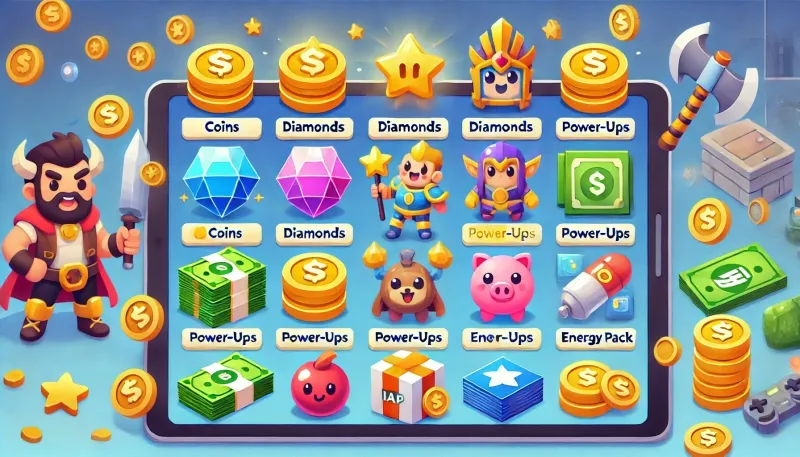Best Practices for Pricing and Bundling in Mobile Games

Effective pricing strategies and bundling strategies are crucial components of mobile game monetization. Setting the right prices for in-app purchases (IAPs) and creating attractive bundles can significantly impact your game's revenue. This blog will delve into best practices for maximizing revenue through strategic pricing and bundling, helping you navigate the complexities of mobile game monetization.
Why Pricing Strategies Matter in Mobile Games
The mobile gaming industry has witnessed an exponential surge in recent years, with millions of apps vying for users' attention and wallets. In this fiercely competitive market, implementing well-crafted pricing strategies is no longer a luxury but a necessity. Pricing holds the power to shape user behavior, influence purchasing decisions, and directly impact revenue streams.
Striking the right balance between affordability and perceived value is crucial. Underpricing a game or its in-app purchases (IAPs) can undermine its perceived quality, while overpricing may deter potential users from even considering the investment. Game studios must navigate this delicate equilibrium, avoiding common pitfalls such as pricing inconsistencies across platforms, failing to account for regional variations, or neglecting to analyze user behavior and market trends.
Exploring Different Pricing Models for In-App Purchases
Mobile game monetization models have evolved significantly, offering developers a diverse array of options to explore. Each model presents its unique advantages and challenges, catering to different game genres, target audiences, and monetization goals.
Tiered Pricing
Tiered pricing involves offering various tiers or packages of in-game content or virtual goods at varying price points. This model allows users to choose the tier that best aligns with their budget and desired level of engagement. For instance, a game might offer a basic tier with limited features for free, while more advanced tiers with additional content or perks come at a premium price.
Dynamic Pricing
Dynamic pricing, also known as real-time pricing, involves adjusting prices based on real-time market conditions, user behavior, and demand patterns. This model leverages data analytics and machine learning algorithms to optimize pricing dynamically, ensuring that prices remain competitive and aligned with user preferences.
Freemium Model
The freemium model has gained significant traction in the mobile gaming industry. Under this approach, users can download and play the game for free, but certain features, content, or virtual goods are available only through in-app purchases. This model aims to attract a large user base by offering a free entry point while monetizing through optional purchases from engaged users.
Best Practices for Setting In-App Purchase Prices
Establishing optimal pricing for in-app purchases requires a strategic approach that considers various factors, including market research, competitor analysis, and user feedback. Here are some best practices to consider:
Conduct Thorough Market Research: Understanding your target audience's demographics, preferences, and spending habits is crucial. Gather data through surveys, focus groups, and analytics tools to gain insights into what users are willing to pay for specific features or virtual goods.
Analyze Competitor Pricing: Evaluate how your competitors price similar offerings, and identify potential gaps or opportunities in the market. This analysis can help you position your game competitively while offering a unique value proposition.
Leverage User Feedback: Actively seek feedback from your existing user base through in-game surveys, social media channels, or dedicated forums. This feedback can provide invaluable insights into user perceptions of pricing, desired features, and areas for improvement.
Consider Regional Variations: Pricing strategies should account for regional differences in purchasing power, cultural preferences, and market dynamics. Tailoring prices to specific regions can enhance user acquisition and retention rates.
Implement A/B Testing: Utilize A/B testing to evaluate the impact of different pricing strategies on user behavior, conversion rates, and revenue. This data-driven approach can help you identify the most effective pricing models for your game.
The Benefits of Bundling in Mobile Games
Bundling is an effective strategy to increase average transaction values and enhance user satisfaction. By offering multiple items or services together at a discounted rate, you can create a sense of value for players. Bundles capitalize on the psychological impact of perceived value, encouraging players to spend more than they might on individual items.
The psychological impact of perceived value plays a crucial role in the success of bundling. When users perceive a bundle as a bargain or a valuable offer, they are more likely to make a purchase. This perception of value can be further amplified by creating a sense of scarcity or exclusivity around certain bundles, driving urgency and increasing conversion rates.
Different Types of Bundles for Mobile Games
Mobile games can offer various types of bundles to attract players:
1. Starter Packs
Starter packs, often offered at a discounted rate, provide new users with a collection of essential resources, virtual goods, or boosts to enhance their initial gaming experience. These bundles aim to engage users early on, encouraging them to invest in the game and potentially leading to future purchases.
2. Limited-Time Offers
Limited-time bundles create a sense of urgency and exclusivity by offering unique or highly desirable items for a limited duration. These bundles can be timed to coincide with special events, holidays, or game updates, fostering a fear of missing out (FOMO) among users and driving impulse purchases.
3. Event-Based Bundles
Event-based bundles are designed to support specific in-game events or challenges. These bundles may include resources, power-ups, or consumable items that aid users in completing event objectives or progressing through challenging levels. By offering tailored bundles, developers can enhance user engagement and monetize event-driven gameplay.
Creating and Pricing Effective Bundles in Mobile Games
Crafting and pricing effective bundles in mobile games requires a strategic approach that combines data-driven decision-making and careful consideration of user behavior. By understanding player preferences and leveraging analytics, developers can create compelling bundles that drive revenue. Here's how to create and price effective bundles that resonate with users:
1. Analyzing User Behavior and Preferences
Leverage in-game analytics and user feedback to identify the most sought-after virtual goods, resources, or features. This data can inform the composition of bundles that align with user preferences. Analyzing player progression data to identify key milestones or pain points where bundles can provide valuable assistance is crucial. For example, offering bundles that aid users in overcoming challenging levels or unlocking new content can be highly appealing.
2. Testing Bundle Combinations
Experiment with different bundle combinations to find the optimal mix of items that maximize perceived value and appeal to various user segments. A/B testing can provide valuable insights into the most effective bundle compositions. Incorporating time-limited incentives or exclusive items into bundles can create a sense of urgency and scarcity, motivating users to make purchases promptly and boosting conversion rates.
3. Leveraging Cross-Promotion Opportunities
Explore opportunities to cross-promote bundles with other games or products within your portfolio. This approach can increase bundle visibility and reach a wider audience, potentially driving additional revenue streams.
4. Analyzing Bundle Composition and Value
Carefully evaluate the individual components of a bundle and their respective market values. Ensure that the bundled price offers a compelling discount compared to purchasing the items separately, while still maintaining a healthy profit margin. Implement pricing anchors, such as displaying the total value of the bundled items alongside the discounted bundle price, to enhance the perception of value and encourage users to view the bundle as a bargain.
5. Offering Tiered Bundle Options
Consider offering bundles at multiple price points to cater to different user segments and budgets. Tiered bundle options can increase the likelihood of users finding a bundle that aligns with their desired level of investment.
6. Monitoring Competitor Pricing
Stay informed about competitor bundle pricing strategies and adjust your pricing accordingly to remain competitive and maintain a strong value proposition.
7. Utilizing Dynamic Pricing
Implement dynamic pricing strategies that adjust bundle prices based on real-time market conditions, user behavior, and demand patterns. This approach can help optimize revenue and ensure that bundle prices remain aligned with user willingness to pay.
By combining these best practices, you can create and price bundles that not only resonate with users but also drive substantial revenue for your mobile game.

Analyzing and Optimizing Your Pricing and Bundling Strategies
Continuous analysis and optimization are key to successful pricing and bundling strategies. Use analytics tools to track the performance of your pricing models and bundles. Key metrics to monitor include:
Revenue Data: Track the number of purchases and revenue generated from different price points and bundles.
Player Engagement: Measure how pricing and bundling strategies impact player retention and engagement.
Feedback Analysis: Collect and analyze player feedback to identify areas for improvement.
Conduct A/B Testing: Implement A/B testing to evaluate the performance of different pricing and bundling strategies simultaneously.
Stay Informed About Industry Trends: Remain up-to-date with the latest industry trends, competitor strategies, and best practices in pricing and bundling.
Conclusion: Maximizing Revenue with Pricing and Bundling
Effective pricing and bundling strategies are essential for maximizing revenue and ensuring player satisfaction in mobile games. By understanding and implementing best practices, you can create compelling offers that drive in-app purchases and enhance the overall player experience. Continuous optimization based on data analysis is key to maintaining a successful monetization strategy.
Striking the right balance between perceived value and profitability is crucial. Game studios need to be agile, and adapt their strategies to evolving market trends, user preferences, and competitor actions. Continuous innovation, coupled with a deep understanding of user behavior and data-driven decision-making, will pave the way for sustainable revenue growth and a loyal user base.
Enhance Your Pricing and Bundling Strategies with Segwise.ai
At Segwise.ai, we understand the complexities of pricing and bundling strategies in the mobile gaming industry. Our AI Agents are designed to empower game studios with data-driven insights, enabling them to jump on LTV growth opportunities faster than anyone else out there. Segwise’s AI Agents enable this by automated root-causing of game metrics and finding causal game metrics for you, every day. All of this without any engineering bandwidth for integration!
To learn more about how Segwise.ai can enhance your pricing and bundling strategies, contact our team today!

Comments
Your comment has been submitted successfully!